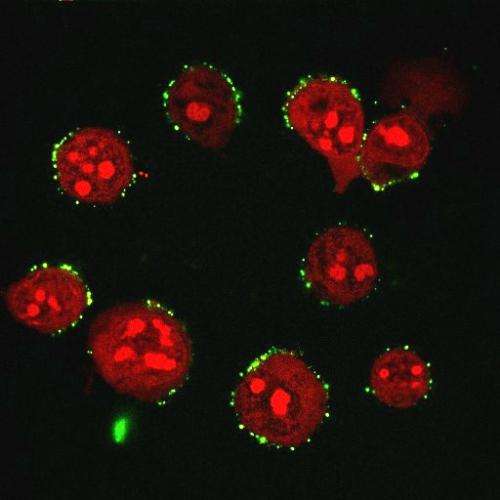Protein-based therapy shows promise against resistant leukemia

Resistance of leukemia cells to contemporary chemotherapy is one of the most formidable obstacles to treating acute lymphoblastic leukemia (ALL), the most common form of childhood cancer. Now researchers at Children's Hospital Los Angeles (CHLA) have designed and developed a new protein-based therapy they believe will prove highly effective against drug-resistant leukemia cells. It may also amplify the potency of standard treatment options such as chemotherapy and radiation therapy.
Their work, published online January 26 by the Journal of Clinical Investigation, demonstrated the efficacy and safety of the new fusion protein in mouse models of aggressive human leukemia using leukemia cells taken directly from patients with ALL.
Occurring at an annual rate of 35 to 40 cases per million people in the U.S., ALL represents approximately 25 percent of cancer diagnoses among children under the age of 15. Historically, ALL had a high mortality rate; nearly 80 percent of children who developed the disease did not survive long term. Today, those numbers have been reversed, with almost 80 percent of children affected by ALL achieving long- term survival.
"That's great news, unless your child is one of the 20 percent," said the study's principal investigator, Fatih M. Uckun, MD, PhD, of the Children's Center for Cancer and Blood Disease at CHLA and the Norris Comprehensive Cancer Center of the University of Southern California (USC). "Despite advances in available therapies, unmet and urgent needs remain in the fight against leukemia. We still have children with disease that our drugs can't help enough. And for patients who relapse, their chances of long-term survival are less than 20 percent. We've got to do better."
TNF-related apoptosis-inducing ligand (TRAIL) is a protein functioning as a ligand that induces apoptosis, or cell death. Produced by the immune system cells, it has the potential to cause apoptosis in tumor cells by binding to two so-called "death receptors", also known as TRAIL-receptor 1 and TRAIL-receptor 2.
"TRAIL is a naturally occurring part of the body's immune system that kills cancer cells without toxicity to normal cells. However, earlier clinical trials using TRAIL as a potential anti-cancer medicine candidate have not been successful, largely because of its propensity to bind, not only to cancer cells, but also to 'decoy' receptors," explained Uckun, who is also a professor of pediatrics at Keck School of Medicine of USC.
Uckun and collaborators discovered a previously unknown protein - CD19-Ligand - a natural ligand of human CD19, which is expressed by almost all ALL cells. They hypothesized that fusing it by genetic bioengineering to the portion of TRAIL (known as sTRAIL) that can kill cancer cells, would produce a powerful weapon against leukemia cells. Unlike chemotherapy drugs, this precision medicine candidate would seek out, bind and destroy only leukemia cells carrying CD19 as the target docking site.
They successfully accomplished this unique assembly of the two proteins in a single "fusion protein" and named this protein therapeutic candidate "CD19L-sTRAIL." In their study, Uckun and collaborators have demonstrated that their engineering converted sTRAIL into a much more potent "membrane-anchored" form that is capable of triggering apoptosis, even in the most aggressive and therapy-resistant form of human leukemia cells.
"Due to its ability to anchor to the surface of cancer cells via CD19, CD19L-sTRAIL was 100,000-fold more potent than sTRAIL, and consistently killed more than 99 percent of aggressive leukemia cells taken directly from children with ALL - not only in the test tube, but also in mice," said Uckun. Administering only two or three doses of CD19L-sTRAIL significantly improved the survival outcome of mice challenged with an otherwise invariably fatal dose of human leukemia cells, without side effects. Its therapeutic potency in mice was superior to that of standard chemotherapy combinations as well as radiation therapy.
"The biggest challenge is to cure patients who experience a recurrence of their cancer, despite intensive chemotherapy," Uckun concluded. "We are hopeful that the knowledge gained from this study will open a new range of effective treatment opportunities for children with recurrent leukemia."



















